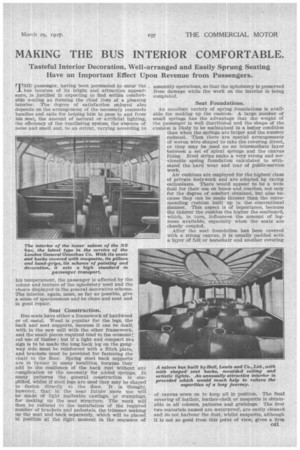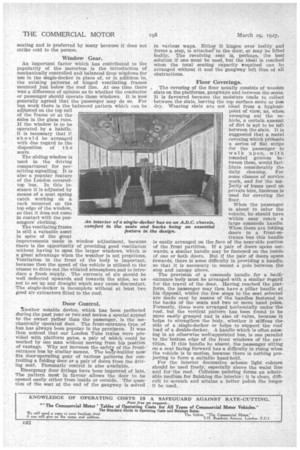MAKING THE BUS INTERIOR COMFORTABLE.
Page 111

Page 112

If you've noticed an error in this article please click here to report it so we can fix it.
Tasteful Interior Decoration, Well-arranged and Easily Sprung Seating Have an Important Effect Upon Revenue from Passengers.
THE passenger, having been persuaded to enter the buS because of its bright and attractive appearance, is justified in expecting to find within comfortable seating as forming the chief item of a pleasing interior. The degree of satisfaction enjoyed also depends on the arrangement of the necessary commode handles and rails for helping him to pass to and from his seat, the amount of natural or artificial lighting, the efficiency of the ventilating system, the absence of noise and smell and, to an extent, varying according to
his temperament, the passenger is affected by the colour and texture of the upholstery used and the choice displayed in the general decorative scheme. The interior, again, must, so far as possible, give a sense of spaciousness and be clean and neat and in good repair.
Seat Construction.
Bus seats have either a framework of hardwood or of metal. Wood is popular for the legs, the back and seat supports, because it can be dealt. with in the saw mill with the other framework, and the small pieces required tend to the economifl, cal use of timber ; but if a light and compact del sign is to be made the long back leg on the gangway side must be reinforced with a flitch plate, and brackets must be provided for fastening the chair to the floor. Spring steel back supports are in favour in many localities, because they
add to the resilience of the back rest without any complication or the necessity for added springs. In many, patterns the general construction is simplified, whilst if steel legs are used they may be shaped to fasten directly to the floor. It is thought, however, that in the near future . more use wjll be made of light malleable castings, or stampings, for making up the seat structure. The work will then be reduced to the Installation of the required number of brackets and pedestals, the trimmer making up the seat and back separately, :which will be placed in position at the right moment in the sequence of assembly operations, so that the upholstery is preserved from damage while the work on the interior is being completed.
• Seat Foundations.
An excellent variety of spring foundations is available for making up the cushion. A large number of small springs has the advantage that the weight of the passenger is well distributed and the shape of the cushion is likely to be maintained in a better condition than when the springs are larger and the number reduced. Then there are special arrangements of woven wire shaped to take the covering direct, or they may be used as an intermediate layer between a set of spiral springs and the canvas lining. Steel strips make a very strong and serviceable spring foundation calculated to withstand the hard wear and tear of public-service work.
Air cushions are employed for the highest class of private bodywork and are adopted by racing enthusiasts. There would appear to be a wide field for their use on buses and coaches, not only for the degree of comfort obtained, but also because they can be made thinner than the corresponding cushion built up in the conventional manner. This aspect is of importance, because the thinner the cushion the higher the seatboard, which, in turn, influences the amount of legroom available, especially when the seats are closely coupled.
After the seat foundation has been covered with a strong canvas, it is usually padded with a layer of felt or horsehair and another covering of canvas sewn on to keep all in position. The final covering of leather, leather-cloth or moquette is obtainable in all colours, patterns and grainings. The first two materials named are waterproof, are easily cleaned and do not harbour the dust, whilst moquette, although It Is not so good from this point of view, gives a firm seating and is preferred by many because it does not strike cold to the person.
Window Gear.
An important factor which has contributed to the popularity of the motorbus is the introduction of mechanically controlled and balanced drop windows for use in the single-decker in place of, or in addition to, the existing patterns of hinged ventilating frames mounted just below the roof line. At one time there was a difference of opinion as to whether the conductor or passenger should operate these windows. It is now generally agreed that the passenger may do so. For bus work there is the balanced pattern which can be _ adjusted on the top rail of the frame or at the sides in the glass runs. If the window is to be operated by a handle, it is necessary that it should be arranged with due regard to the disposition of t h e seats.
The sliding window is used in the driving compartment for permitting signalling. It is also a popular feature of the London coveredtop bus. In this instance it is adjusted by means of a neat spring catch working on a rack mounted on the top edge of the window, so that it does not come in contact with the passengers' clothing.
The ventilating frame is still a valuable asset in spite of the great improvements made in window adjustment, because there is the opportunity of providing good ventilation without having to open the larger windows, which is a great advantage when the weather is not propitious. Ventilation in the front of the body is important, because then the speed of the vehicle is utilized to the utmost to drive out the vitiated atmosphere and to introduce a fresh supply. The currents of air should be well deflected upwards and towards the sides, so as not to set up any draught which may cause discomfert. The single-decker is incomplete without at least two good air extractors fitted to the roof. An interior of a single-decker bus on an A.D.C. chassis, comfort in the seats and backs being an essential feature in the design.
Door Control.
Xnather notable device, which has been perfected during the past year or two and makes a special appeal to the owner rather than the passenger, is the mechanically operated door. The front-entrance type of bus has always been popular in the provinces. It was then noticed that our London Tube trains were provided with platform gates, a pair of which could be worked by one man without moving from his position of vantage. Why not increase the safety of the frontentrance bus by similar means, The boy-builder now fits door-operating gear of various patterns for controlling a folding door or a pair of doors from the driving seat. Pneumatic control is also available.
Emergency door fittings have been improved of late. The pattern most in favour allows the door to be opened easily either from inside or outside. The question of the seat at the end of the gangway is solved in various ways. Either it hinges over bodily and forms a step, is attached tothe door, or may be lifted bodily. The revolving seat is, perhaps, the best solution if one must be used, but the ideal is reached when the total seating capacity required can be arranged without it and the gangway left free of all obstructions.
Floor Coverings.
The covering of the floor usually consists of wooden slats on the platforms, gangways and between the seats. It is favoured because the moisture tends to collect between the slats, leaving the top surface more or less dry. Wearing slats are not ideal from a hygienic paint of view, as, when sweeping out the vehiele, a certain amount of dirt is apt to be left between the slats. It is suggested that a metal covering which presents a series of fiat strips for the passenger to walk upon, with rounded grooves between them, would facilitate considerably the daily cleaning. For some classes of service work, and for the majority of buses used on private hire, linoleum is used for coveripg the floor.
When the passenger is about to enter the vehicle, he should have within easy reach a large commode handle. When there are folding doors to a front-entrance bus this handle is easily arranged on the_face of the near-side portion of the front partition. If a pair of doors opens outwards, a similar handle may be fastened on the inside of one or both doors. But if the pair of doors opens inwards, there is some difficulty in providing a handle, so that it is necessary to mount a pole between the step and canopy above.
The provision of a commode handle for a backentrance body must be arranged with a similar fegard for the travel of the door. Having reached the platform, the passenger may then have a pillar handle at his disposal, whilst the few steps to the seat selected are made easy by means of the handles fastened to the backs of the seats and two or more hand poles. Formerly, these were arranged horizontally under the roof, but the vertical pattern has been found to be more easily' grasped and is also of value, because it helps to strengthen the body, whether it stiffens the side of a single-decker or helps to support the roof load of a double-decker. A handle which is often MISSing in an otherwise well-appointed bus, is one parallel to the bottom edge of the front windows of the partition. If this handle be absent, the passenger sitting on a seat facing forward has a difficulty in rising when the vehicle is in motion, because there is nothing projecting to form a suitable hand-hold.
For the interior decorative scheme light colours should be used freely, especially above the waist line and for the roof. Cellulose painting forms an admirable medium for finishing the Interior; it is clean, difficult to scratch and attains a better polish the longer it be used.












































































































































































